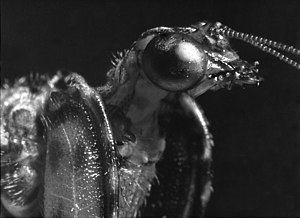Mantispidae
Mantispidae, commonly known as mantidflies, mantisflies, or mantispids, are a family of insects within the order Neuroptera. They are notable for their striking resemblance to praying mantises, due to convergent evolution, although they are not closely related. Mantidflies have raptorial forelegs similar to those of mantises, which they use to capture prey. Their size, shape, and coloration can vary significantly among species, but they generally have elongated bodies, wings, and large, compound eyes.
Description[edit | edit source]
Mantidflies possess a unique combination of physical traits that distinguish them from other neuropterans. They have elongated bodies, typically ranging from 10 to 50 mm in length, with two pairs of wings that are often transparent or patterned. The forelegs are modified into powerful grasping tools, resembling those of a praying mantis, which they use to snatch prey. Their heads are mobile and equipped with large, bulging eyes, and they have long antennae.
Life Cycle and Behavior[edit | edit source]
The life cycle of mantidflies includes several stages: egg, larva, pupa, and adult. The larval stage is particularly interesting due to its parasitic behavior in some species. Mantidfly larvae may parasitize spider eggs, with the larva entering the egg sac and consuming the spider eggs. Other species have larvae that are free-living predators.
Adult mantidflies are predators and are known to feed on a variety of small insects and arthropods. They are mostly nocturnal and use their raptorial forelegs to capture prey. Their mating behavior and reproductive strategies can vary, but many exhibit complex courtship rituals.
Distribution and Habitat[edit | edit source]
Mantidflies are found worldwide, with a significant diversity in tropical and subtropical regions. They inhabit a variety of environments, including forests, meadows, and gardens, where they can be seen hunting or resting on vegetation.
Taxonomy and Evolution[edit | edit source]
The family Mantispidae is part of the order Neuroptera, which also includes lacewings and antlions. The resemblance between mantidflies and praying mantises is a result of convergent evolution, where unrelated species develop similar traits independently due to similar ecological niches or lifestyles.
Conservation[edit | edit source]
While many mantidfly species are not considered endangered, their presence and abundance can be indicators of ecosystem health. Habitat destruction and pesticide use can impact their populations, highlighting the importance of conservation efforts in maintaining biodiversity.
In Popular Culture[edit | edit source]
Due to their unique appearance and predatory behavior, mantidflies have captured the imagination of many and occasionally appear in nature documentaries and educational materials. However, they are not as widely recognized as some of their insect counterparts.
This article is a Neuroptera related stub. You can help WikiMD by expanding it!
Search WikiMD
Ad.Tired of being Overweight? Try W8MD's physician weight loss program.
Semaglutide (Ozempic / Wegovy and Tirzepatide (Mounjaro / Zepbound) available.
Advertise on WikiMD
|
WikiMD's Wellness Encyclopedia |
| Let Food Be Thy Medicine Medicine Thy Food - Hippocrates |
Translate this page: - East Asian
中文,
日本,
한국어,
South Asian
हिन्दी,
தமிழ்,
తెలుగు,
Urdu,
ಕನ್ನಡ,
Southeast Asian
Indonesian,
Vietnamese,
Thai,
မြန်မာဘာသာ,
বাংলা
European
español,
Deutsch,
français,
Greek,
português do Brasil,
polski,
română,
русский,
Nederlands,
norsk,
svenska,
suomi,
Italian
Middle Eastern & African
عربى,
Turkish,
Persian,
Hebrew,
Afrikaans,
isiZulu,
Kiswahili,
Other
Bulgarian,
Hungarian,
Czech,
Swedish,
മലയാളം,
मराठी,
ਪੰਜਾਬੀ,
ગુજરાતી,
Portuguese,
Ukrainian
Medical Disclaimer: WikiMD is not a substitute for professional medical advice. The information on WikiMD is provided as an information resource only, may be incorrect, outdated or misleading, and is not to be used or relied on for any diagnostic or treatment purposes. Please consult your health care provider before making any healthcare decisions or for guidance about a specific medical condition. WikiMD expressly disclaims responsibility, and shall have no liability, for any damages, loss, injury, or liability whatsoever suffered as a result of your reliance on the information contained in this site. By visiting this site you agree to the foregoing terms and conditions, which may from time to time be changed or supplemented by WikiMD. If you do not agree to the foregoing terms and conditions, you should not enter or use this site. See full disclaimer.
Credits:Most images are courtesy of Wikimedia commons, and templates Wikipedia, licensed under CC BY SA or similar.
Contributors: Prab R. Tumpati, MD




